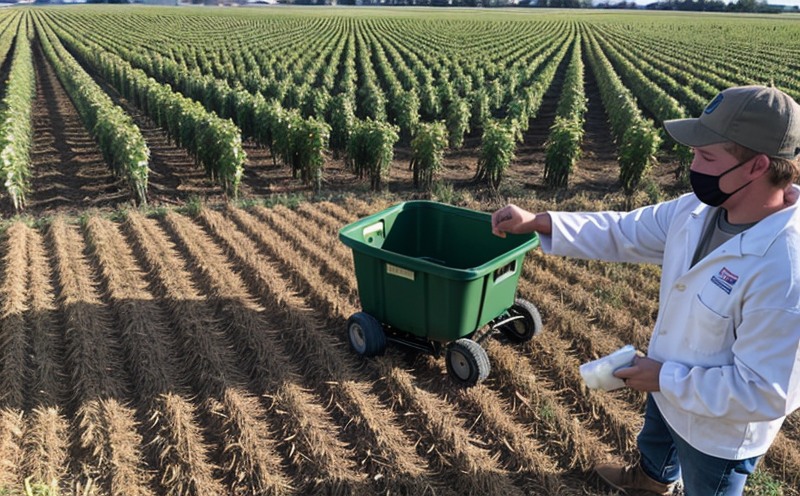Respiration Rate Testing in Fruits & Vegetables
The respiration rate testing of fruits and vegetables is a critical process used by laboratories to ensure the quality, freshness, and shelf life of produce. This test measures the metabolic activity of fresh produce, which can help predict its storage potential and overall viability. Understanding the respiration rate allows for better decision-making in post-harvest handling, transportation, and marketing.
Post-harvest physiology plays a crucial role in determining how fruits and vegetables will behave during storage and transport. By measuring the respiration rate, we can identify the optimal conditions for maintaining freshness and extending shelf life. This is particularly important as global trade continues to expand, requiring consistent quality standards across international borders.
The respiration process involves the consumption of oxygen and release of carbon dioxide by fresh produce. In controlled environments, such as refrigerated storage facilities or during transport, it's vital to manage these parameters carefully. By accurately measuring respiration rates, we can tailor storage conditions to maximize the life span of fruits and vegetables.
The accuracy of respiration rate testing is paramount for ensuring consistent quality in international trade. Standards like ISO 14765-2 provide guidelines on how to conduct such tests, ensuring that all involved parties use a common methodology. Compliance with these standards can significantly impact the reputation of producers and importers.
Respiration rate testing also aids in understanding the maturity and ripeness of fruits and vegetables. This information is valuable for optimizing harvesting times, reducing waste, and improving the overall supply chain efficiency. By integrating respiration rate data into decision-making processes, we can enhance the quality of produce reaching consumers worldwide.
In summary, respiration rate testing is an essential tool in maintaining high-quality standards for fruits and vegetables. It ensures that fresh produce meets international quality criteria, supports sustainability efforts, and enhances market competitiveness through better supply chain management. By leveraging this technology, laboratories can contribute significantly to the agricultural sector's ongoing pursuit of excellence.
Customer Impact and Satisfaction
The implementation of respiration rate testing in fruits and vegetables has a profound impact on customer satisfaction within the agricultural and forestry sectors. By ensuring that produce meets stringent quality standards, laboratories can help reduce waste and loss during storage and transport. This not only benefits the environment but also enhances the profitability of businesses involved in the supply chain.
Quality managers benefit from respiration rate testing as it provides valuable insights into the optimal conditions for maintaining freshness. Compliance officers can use this data to ensure that all produce meets international standards, thereby avoiding regulatory issues and reputational damage. R&D engineers find value in respiration rate testing by gaining a deeper understanding of how different environmental factors affect post-harvest quality.
For procurement teams, accurate respiration rate testing ensures they source the highest quality produce consistently. This leads to improved product offerings and better customer satisfaction. By leveraging this technology, laboratories can help businesses achieve their sustainability goals while maintaining competitive advantage in the market.
In conclusion, respiration rate testing is a key factor in enhancing customer satisfaction across various stakeholders in the agricultural sector. It supports sustainable practices, ensures compliance with international standards, and contributes to the overall success of supply chain management efforts.
Environmental and Sustainability Contributions
The respiration rate testing of fruits and vegetables plays a vital role in promoting sustainability within the agricultural sector. By accurately measuring metabolic activity, laboratories can help minimize waste and loss during storage and transport. This not only reduces environmental impact but also supports more efficient use of resources.
One significant benefit is reduced food waste. By understanding respiration rates, producers and distributors can better manage post-harvest conditions, ensuring that produce remains fresh for longer periods. This leads to less spoilage and more efficient utilization of resources such as energy and water in storage facilities.
The testing also contributes to the development of greener supply chains by providing data on optimal storage temperatures and durations. This information can be used to design more sustainable transportation methods, reducing carbon emissions associated with longer journeys or higher energy consumption.
Moreover, respiration rate testing helps in identifying the best practices for handling produce throughout its journey from farm to table. By optimizing these processes, laboratories contribute to a more resilient and environmentally friendly agricultural sector. This aligns with broader sustainability goals set by organizations like the United Nations Sustainable Development Goals (SDGs).
In summary, respiration rate testing is an integral part of sustainable practices in agriculture. It supports efficient resource use, reduces waste, and promotes greener supply chains, all while enhancing overall quality and customer satisfaction.
Competitive Advantage and Market Impact
Respiration rate testing offers significant competitive advantages in the agricultural sector by providing precise data on post-harvest quality. This information is crucial for maintaining high standards of freshness and shelf life, which directly impacts customer satisfaction and loyalty.
By leveraging respiration rate testing, businesses can differentiate themselves through superior product offerings that meet or exceed international standards. Compliance with these standards not only enhances reputation but also opens up opportunities for export markets where stringent quality controls are enforced.
R&D engineers benefit from respiration rate testing as it enables them to innovate and develop new techniques for preserving fruit and vegetable freshness. This innovation can lead to improved packaging solutions or novel storage methods that further enhance shelf life and quality.
For procurement teams, accurate respiration rate data helps in selecting the best suppliers based on consistent high-quality produce. This ensures a reliable supply chain, which is essential for maintaining competitive advantage in volatile markets. By focusing on sustainability and quality, businesses can build long-term relationships with customers and stakeholders.
The impact of respiration rate testing extends beyond individual companies to influence market trends favorably towards higher quality standards. As more players adopt these practices, it sets a new benchmark for excellence that benefits the entire sector. This collective effort contributes to healthier ecosystems and more robust economies.





